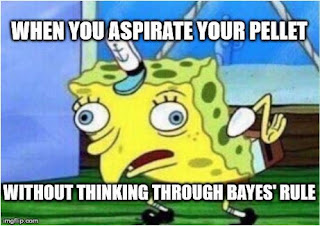The Power of Statistics
“Aaaaaah…..” “Oh, no!” (returning off the aspirator) “I’m
sorry.” “What do we do?” (squeezing the aspirator tube) “Can we break the vacuum?”
“Let’s pull together.” (pulling on the aspirator tube in two opposite directions
unsuccessfully…)
On the third day of Mod 1, my partner and I aspirated our
+IPTG induced pellet. I was so convinced that we should aspirate the left over
supernatant with an aspirator because it worked well for the –IPTG control
pellet. Why did an n=1 experiment convince me that aspirating would be safe?
Consider a hypothetical situation where before any experimentation,
I think there’s a 1/2 probability that the aspirator cannot aspirate a pellet,
and 1/2 probability that aspirator can aspirate a pellet and does it half of
the time. One successful aspiration should only increase the probability that
the aspirator cannot aspirate a pellet to Pconditional = 0.5/(0.5+0.25)
= 2/3. So a successful aspiration should increase my confidence in
aspiration from 1/2 to 2/3. In reality, my confidence in aspiration went up from 50% to 98% after one success.
Do our brains always process statistical information
logically? Can our brains directly tell whether we can make a
conclusion based on difference in data? I think the answer is no. And I learned
it the hard way as my partner and I lost our +IPTG pellet on the third day of
class.
On the flip side, losing the pellet has increased my appreciation
for statistics, that statistically analysis based on mathematically formulas are
necessary to make sound conclusions. Speaking of statistical analysis, most of
the data we got for Mod 1 were not statistically significant (including all the
data form PPIase assay). What can we conclude from statistically insignificant
data? How do we draft a coherent story in the data summary based on data that’s
mostly insignificant?
Luckily, one of our ligands had significant effect in the
DSF. My lab partner and I learned that statistically insignificant trends can
be used to support conclusions drawn from significant data. Also,
insignificance could mean that a ligand just doesn’t bind FKBP12, which is useful
information to know for other researchers. Statistically insignificant trends
can also motivate further experiments that can lead to a more confident
conclusion.
Another difficulty my lab partner and I faced was due to our
personal work preferences. While my partner is on top of things and completes
assignments early, I have a strong tendency to procrastinate although I feel
bad when procrastinating. This difference has led to “significant” stress for
both of us. For the next 2 modules, I will try to work on assignments early and
be less last minute. Overall, I look forward to future experiments, and for the power of statistics to shine through data analysis.

-Alexa Guan
ReplyDelete(I forgot to sign)